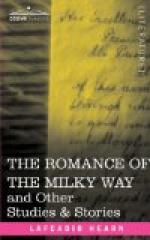The old Japanese, like the old Greeks, had their flower-spirits and their hamadryads, concerning whom some charming stories are told. They also believed in trees inhabited by malevolent beings,—goblin trees. Among other weird trees, the beautiful tsubaki (Camellia Japonica) was said to be an unlucky tree;—this was said, at least, of the red-flowering variety, the white-flowering kind having a better reputation and being prized as a rarity. The large fleshy crimson flowers have this curious habit: they detach themselves bodily from the stem, when they begin to fade; and they fall with an audible thud. To old Japanese fancy the falling of these heavy red flowers was like the falling of human heads under the sword; and the dull sound of their dropping was said to be like the thud made by a severed head striking the ground. Nevertheless the tsubaki seems to have been a favorite in Japanese gardens because of the beauty of its glossy foliage; and its flowers were used for the decoration of alcoves. But in samurai homes it was a rule never to place tsubaki-flowers in an alcove during war-time.
The reader will notice that in the following ky[=o]ka—which, as grotesques, seem to me the best in the collection—the goblin-tsubaki is called furu-tsubaki, “old tsubaki.” The young tree was not supposed to have goblin-propensities,—these being developed only after many years. Other uncanny trees—such as the willow and the [’e]noki—were likewise said to become dangerous only as they became old; and a similar belief prevailed on the subject of uncanny animals, such as the cat—innocent in kittenhood, but devilish in age.
Yo-arashi ni
Chishiho itadaku
Furu tsubaki,
Hota-hota ochiru
Hana no nama-kubi.
[When by the night-storm
is shaken the blood-crowned and
ancient tsubaki-tree, then
one by one fall the gory heads of
the flowers, (with the sound
of) hota-hota![61]]
[Footnote 61: The word furu in the third line is made to do double duty,—as the adjective, furu[i], “ancient”; and as the verb furu, “to shake.” The old term nama-kuhi (lit., “raw head”) means a human head, freshly-severed, from which the blood is still oozing.]
Kusa mo ki mo
N[’e]mur[’e]ru koro no
Sayo kaz[’e] ni,
M[’e]hana no ugoku
Furu-tsubaki kana!
[When even the grass and the trees are sleeping under the faint wind of the night,—then do the eyes and the noses of the old tsubaki-tree (or “the buds and the flowers of the old tsubaki-tree”) move![62]]
[Footnote 62: Two Japanese words are written, in kana, as “m[’e]”—one meaning “a bud;” the other “eye.” The syllables “hana” in like fashion, may signify either “flower” or “nose.” As a grotesque, this little poem is decidedly successful.]
Tomoshibi no
Kag[’e] ayashig[’e] ni
Miy[’e]nuru wa
Abura shiborishi
Furu-tsubaki ka-mo?




